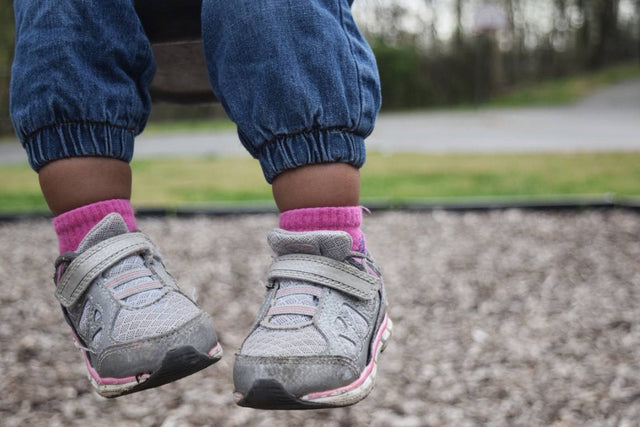When Do Babies Need Shoes?

Tiny, name brand running sneakers. Sparkly dress-up flats. Wee jelly sandals and loafers…baby shoes are really, really cute. It’s almost impossible not to buy them all up! But just because they’re super-adorable, doesn’t necessarily mean your tot needs them. Worse, putting the wrong shoes on a budding walker may hinder their newfound skills. Here, we break down what your baby’s growing feet really need.
Do babies need shoes?
The short answer is no. Your baby does not need shoes until they start walking, according to the American Academy of Pediatrics. The only thing younger babies need on their feet are socks to keep them warm.
Think about it like this: The purpose of shoes (other than to look cute, of course), is to protect the feet. But if your precious nugget is dangling from a baby carrier, relaxing in the stroller, or scooting on their hands and knees, there’s nothing to protect their feet from. If warmth is what you crave for your baby’s tootsies, cozy socks, footed snowsuits, and stroller sacks do the trick.
What’s the harm of baby shoes?
Beyond not needing shoes, putting shoes on babies who are just learning to balance on their growing feet can be a downright hindrance. Shoes with inflexible soles can prevent a baby from learning how to flex and move their feet to walk. That's why pediatricians recommend that babies learn to walk barefoot in a safe space, like on their living room floor. This’ll help strengthen the muscles and tendons in your baby’s feet.
When do babies need shoes?
There is no particular age at which your baby will need shoes, but a good rule of thumb is to wait until they’ve learned to walk and show signs of wanting to be up and about. The general milestone guideline for when a baby begins to walk is:
-
Between 6 and 13 months: crawling
-
Between 9 and 12 months: pulling themselves up
-
Between 8 and 18 months: walking
It is important to remember that not all babies are on the same trajectory. If your child’s progress doesn’t fit neatly in the above timeline, it doesn't necessarily mean something is wrong. Don’t hesitate to talk to your pediatrician about any concerns.
Should babies wear shoes when learning to walk?
Babies should wear shoes when walking outside or on uneven surfaces. But indoors, barefoot is best for your baby’s still-developing feet. (Often, babies won't even tolerate shoes while they’re busy trying to master walking!) Again, when your baby’s tootsies are shoe-free, it bolsters their muscle strength, plus it encourages balance, posture, and coordination. If you feel your baby needs a little something-something on their feet, you can use booties or socks with non-skid bottoms to prevent slipping while walking inside.
What should parents look for in baby shoes?
When babies start to walk, and parents are ready to buy their first pair of shoes, it’s essential that fashion takes a back seat to function. But don’t fret too much: There are so many adorable and appropriate, baby shoe options. Just remember that your baby's feet are growing fast, and stability, flexibility, and comfort are musts.
To pick the perfect pair of baby shoes, look for a few key features, like:
-
Lightweight shoes
-
Flexible soles: Any shoes with hard, stiff soles can restrict foot movement
-
Correct fit: Make sure the shoes aren’t too loose or too tight. There should be about a thumb’s width of room in the toe box.
-
Non-skid soles: This is important to help prevent slips and falls
It’s also a wise idea to consider cost. It’s common for a baby to outgrow a pair of shoes within just two or three months! For this reason, you may not want to splurge on lots of pairs of shoes and instead start with one affordable and easy-to-replace pair.
For more tips and tricks for ushering your sweet one through toddlerhood, check out Happiest Toddler on the Block.